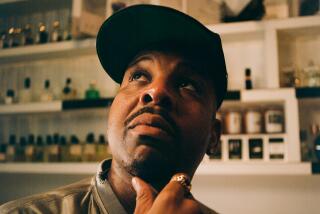Chemistry Lab
- Share via
Two universes are converging this recent evening in the Beverly Hilton’s Empire Room: Science is meeting the real world.
From one galaxy comes Clive Jennings-White, who received bachelor’s and doctorate degrees from the University of Cambridge, was a Fulbright scholar and post-doctoral fellow at Stanford. He does research at the University of Utah. Of average height, he wears gold-rimmed glasses and a blue blazer. A white shirt accompanies his college tie. Words like “skatole” and “androstenone” dance from his lips in a London-meets-Salt Lake City accent. He has the friendly, confident air of a man who spends all day jiggling obedient chemicals in test tubes.
Jennings-White is tossing out his exotic scientific terms to an overwhelmingly female crowd of 50 perfume demonstrators from Macy’s. They’re mostly in their late 20s and 30s. What they seem to have in common is the habit of spending all the time they aren’t demonstrating perfumes hanging around the makeup counter. They fear no eyeliner.
Jennings-White has come to talk about the molecular structure of Realm perfume. The key point he must render intelligible is that Realm is the first scent to contain synthesized human pheromones. Natural pheromones are biochemical cues the body releases to transmit messages to the brain. For a number of complicated biological reasons, that process supposedly gives people a feeling of well-being. Employing pheromones as a magic ingredient in separate men’s and women’s scents takes the idea of smell good, feel good to a new level. Needless to say, a lot of money is riding on communicating that point to the public, a mission that partly falls to Jennings-White’s audience.
As a hundred eyes focus on him, he talks about pheromones and their detection by the human vomeronasal organ. He tells the crowd of receptor cells and tests that measure electrical response, about research and studies and blind tests. He’s got charts and slides showing the human skull split open like a cantaloupe.
The demonstrators listen quietly, nod blankly and quickly distill the complex information down to its essence: Sex sells.
As they listen, the women exhibit bemused looks, behind which rests the wealth of wisdom they’ve gained from spritzing customers. Jennings-White might know the molecules, they know the customers.
“I didn’t get the science thing,” says fragrance model Ann Bucklin. “I did get that it attracts the opposite sex.”
Well, not exactly.
What Realm claims is that the synthesized human pheromones in the perfume “promote attractiveness by enhancing feelings.” The wearer feels more appealing. The company explicitly states that the scent does not arouse sexual feelings. It is not an aphrodisiac. Jennings-White said so, apparently to little effect, just a minute ago.
“People don’t want details,” says saleswoman Carolyn Drozd. “They want to know what a perfume does for them. I would say to a customer: ‘Would you like to try a sexy new fragrance?’ ”
Another woman says a “trade secret” of the fragrance demonstration biz is: “People want what’s hot. They want to be noticed and make a statement. If you tell them the perfume will do that, they’ll buy it.”
When his lecture is over, Jennings-White takes a seat. He agrees that the neuropsychological aspect of his presentation might have been missed by the audience, but he hopes they’ll remember “the point of differentiation” Realm has from other fragrances.
“Maybe they won’t remember all the content of the message I gave,” he says, wiping his glasses, “but they will remember there is content.”
They remember the content exceptionally well. Sex sells.






